|
|
Hastings

|
|
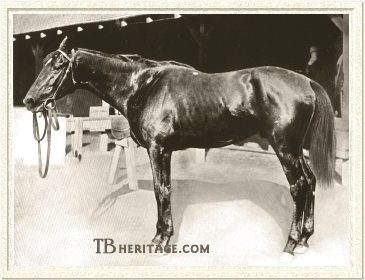 |
|
|
On June 17, 1917 at the Nursery Stud near Lexington, Kentucky, Hastings, a legend in his lifetime for his fiery spirit, was humanely put down. In his youth he had been the terror of the studmen at the farm. At the age of 24 he was severely crippled with paralysis, yet his spirit was as combative as ever. The spirit and heart of Hastings lived on past his death, embodied in the descendants of his famous son, Fair Play, and grandson Man o' War.
Hastings was foaled in 1893 at the farm of Dr. J.D. Neet near Versailles, Kentucky. Dr. Neet was a small-scale breeder, and had only a small band of broodmares. Even so, he managed to get his mares booked to the most fashionable stallions of the day. One of his mares was a plain brown mare named Cinderella. Bred in England, Cinderella was not fashionably bred nor physically attractive, being described as small and weedy. Her unattractiveness extended to her personality. She was nothing like her literary namesake, having a personality more like Cinderella's evil sisters, for she was mean tempered and vicious.
|
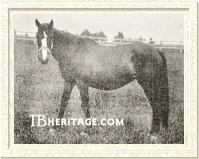
Cinderella
| |
On her sire's side, her pedigree was suspect, as she was said to be by Blue Ruin or Tomahawk, "with Tomahawk preferred." Her dam, the unraced Manna, was by Brown Bread, a winner of the Northumberland Plate. Of the two sires given, Tomahawk was probably the better. He was a winner of the Lincolnshire Handicap, and boasted a fine pedigree, as he was by King Tom out of the One Thousand Guineas winning mare Mincemeat (by Sweetmeat), and was a full brother to One Thousand Guineas winner Tomato.
|
The female line of Cinderella had been somewhat quiescent for several years prior to her birth, yet it was a family which had produced more than its fair share of top class performers. Cinderella traced to the Orville mare, and from her descended Oaks winner Iris; St. Leger and Doncaster Cup winner Charles XII; Doncaster Cup winner Laurel; and Sweetmeat, an unbeaten winner of sixteen races at age three whose career stakes victories included the Doncaster Cup and the Ascot Gold Vase. Sweetmeat had sired three classic winners, including Derby winner Macaroni. If Tomahawk was indeed the sire of Cinderella, it made her inbred 3x3 to the half siblings Sweetmeat and the Don John mare.
Neet acquired Cinderella cheaply. She was bred by Sir Thomas Throckmorton in England. She was imported to Kentucky by Egmont Lawrence, along with the filly Tarantella. Upon their arrival in Lexington, both fillies were purchased by Dr. Neet, Cinderella costing just $500. She was sent to the training stable of Major Barak Thomas and broken by John Clay. She displayed good speed in her work, but Dr. Neet decided against racing her, instead opting to breed her as a three-year-old. Her first foal, Foreigner, was born in 1889. Cinderella reaped immediate benefits as a producer for Dr. Neet, for her produce before Hastings included the aforementioned Foreigner, as well as Ferrier, and Handsome, all high class stakes performers. After Hastings, Cinderella kept on producing good ones, including Kentucky Derby winner Plaudit; Polly Flinders, the dam of Prudery; and Migraine. Hastings was Cinderella's first foal by the champion racehorse Spendthrift.
Spendthrift was the antithesis of Cinderella in terms of his parentage, for there was not doubt about his parentage. He was a son of Australian, a stakes-winning son of England's first Triple Crown winner West Australian. Despite sharing the stallion barn with Lexington at Woodburn Farm, Australian came up with such notable performers as Baden-Baden, Springbok, Joe Daniels, and Maggie B.B. Spendthrift was out of an unraced sister to the champion mare Idlewild, and was a brother to Fellowcraft, Rutherford, and Mozart. With such a pedigree, Spendthrift was expected to be a good horse, and he was. He was undefeated as a two-year-old on the Kentucky--Tennessee circuit for owner Daniel Swigert in 1878 before his sale to financier James R. Keene. Shipped to New York, Spendthrift at three was a winner of several races, including the Belmont Stakes, and was named co-champion three-year-old, along with Falsetto, for 1879. Spendthrift was a success at stud right from the beginning, getting Kingston, winner of 89 races, thirty of them stakes, in his first crop.
Hastings on the Turf
Hastings, the result of the union of the handsome, chestnut Spendthrift and the weedy, ill-tempered Cinderella, was a brown colt with a star on his forehead and more than his fair share of his dam's disagreeable personality. Neet sold Hastings at auction as a yearling, and he went to the partners of David Gideon and John Daly for $2800.
Sent to New York to race at age two, Hastings won his first three races with consummate ease, including a defeat of the highly regarded Hanover colt Handspring in the fine time of 1:00 2/5. Gideon and Daly then decided to dissolve their racing partnership, and consequently sold the majority of their stock at public auction. Gideon wanted to keep Hastings for his own stable, with an eye to capturing the Futurity. At the sale, he hoped to intimidate other buyers by offering an opening bid of $25,000 for Hastings. He was unpleasantly surprised to find August Belmont II unfazed by this, and willing to go to whatever it took to land the son of Spendthrift. At the end of the day, Hastings was a new member of the August Belmont stable, his new owner having paid a record $37,000 to obtain him.
Hastings was shipped to Saratoga, but fell ill there. He was well enough to start in the Futurity at Sheepshead Bay in the fall, but his illness may have compromised his form, as he finished fifth. Ironically, Gideon did win the Futurity, as the winner, Requital, was one of the horses he had kept from the sale of the partnership's horses. Hastings raced no more that season.
At three, Hastings was one of the best of his year. He lost the Withers by only a head to Handspring, then defeated older horses in taking the Toboggan Handicap. The next start for Hastings was the Belmont Stakes. The running of the race proved classic, as in the stretch, Handspring seemed on the verge of certain victory. Hastings kept coming, and at the wire, beat Handspring by a head. Hastings followed that up with a second to stablemate Margrave in the Tidal Stakes, and then an unplaced performance in the Lawrence Realization to end his season.
At four, Hastings ran more times than his first two seasons combined. He faced the starter twelve times, won four times, was second six times, and unplaced only twice. After finishing fourth to Voter in the Metropolitan Handicap, Hastings dead-heated for the win with Clifford in the Kearney Handicap. At Coney Island in the Fall Handicap, Hastings finished fourth to Ornament, Cleophus, and Voter. He lost by only a head to Belmar in the Ocean Handicap, then was beaten less than a length by Ben Brush in the Omnium Handicap, with Clifford third. Hastings won next out, over six furlongs, defeating Ornament, then ran a courageous second to Ben Brush in the First Special. He was second by a neck in the Culver Handicap. He then won a five furlong race, carrying 130 pounds, at Morris Park, followed by a win in the Westchester Highweight Handicap, where he toted 140 pounds to victory. He closed out his four-year-old campaign with two second place finishes.
Hastings in the Stud
That Hastings had so productive a season was remarkable, given that his temperament had become a tremendous problem. He resented being tacked up, and fought savagely. He resented training, and it required all the strength exercise boys and jockeys had to control him. When he was retired to stud at Belmont's Nursery Stud outside Lexington, his racetrack caretakers no sooner heaved a collective sigh of relief to see him gone, than the personnel at Nursery Stud found they had to literally carry a big stick in the presence of the volatile stallion.
So intense was his fiery nature, the stallion men dared not try and catch him unless armed with a long stick. Eventually, a ramp was built from his box to his paddock, which greatly reduced the need to handle him. On one occasion, Hastings took a lunge at a stablehand, but slipped and missed his intended target. The man was fortunate to escape by rolling out of the stable door.
At the beginning of his stud career, the premier stallion at Nursery Stud was Henry of Navarre, and it was he who got the choice mares. It made no difference to Hastings, who proved an astounding success right from the start. By 1902, at the age of nine, he led the American general sire list, with only two and three-year-olds racing, at the time an unprecedented feat.
The first two crops of Hastings were outstanding. The first crop arrived in 1899, and included two of the stallion's best performers, Masterman and Gunfire. MASTERMAN, produced from Lady Margaret, by The Ill-Used, was bred and raced by August Belmont. He was a decent two-year-old, winning the United States Hotel Stakes, finishing second in the Autumn Maiden Stakes, and third in the Brighton Junior Stakes and Saratoga Special. At three, Masterman emulated his sire by winning the Belmont Stakes. He did not make a successful sire.
|
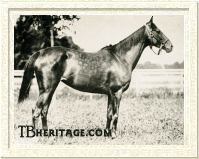
Gunfire
| |
The champion of the first crop of Hastings was William Collins Whitney's filly GUNFIRE. Produced from the Royal Hampton mare Royal Gun, she was a top class filly from her earliest racetrack appearances. She captured such races as the Venus Stakes and Mermaid Stakes, but her finest season came as a four-year-old in 1903. She earned her championship as the country's best older female by virtue of her victory in the Metropolitan Handicap and a gallant second in the Brooklyn Handicap. Gunfire was not a successful broodmare in the short term, but she did become the second dam of the high class Sweep filly Untidy, winner of the Kentucky Oaks and Alabama Stakes, and placed in several other major stakes, including the Lawrence Realization, Pimlico Oaks, and Coaching Club American Oaks.
|
NAMTOR and AMICITIA were also members of Hastings' first crop. Namtor (out of Nineveh, by The Ill-Used), ran third in the Preakness of 1902 to Old England, and Amicitia (out of Fides, by The Ill-Used), was a winner of the important Fashion Stakes.
Members of the 1900 crop included FIRE EATER, a full brother to Amicitia, and a winner of the Iroquois and Autumn Stakes; GLORIOSA (out of Glory, by The Ill-Used), ran second in the Gazelle Handicap; LORD OF THE VALE (out of Lady Violet, by The Ill-Used), was a good two-year-old, winning the Grand Consolation Stakes and finishing second in the Futurity. At four, he was a winner of the Saratoga Handicap and Seashore Handicap. Another member of the 1900 crop was MIZZEN (out of Donna Mia, by The Ill-Used). At two, he was a winner of several races, including the Juvenile Stakes and National Stallion Stakes. At three, he took the Toboggan Handicap.
In just his first two crops, Hastings was the sire of a Belmont Stakes winner, a champion filly, and two runners who were classics-placed. Masterman was his sire's leading earner in 1902, the year he led the general sire list. That horse's full brother, MAGISTRATE was foaled in 1901, and though not quite as good as his elder brother, nevertheless won his share of major stakes races, including the National Stallion Stakes, Tremont, and Manhanset Stakes.
BLANDY, foaled in 1902, was produced from the Kingfisher mare Belinda. Blandy's major stakes victory came in the 1905 Withers Stakes. He also finished third to Harry Payne Whiyney's filly Tanya in the Belmont Stakes. However, Blandy is famous for a bit of trivia -- he won the very first race ever held at Belmont Park, when it opened in 1905. In the same crop as Blandy was GLORIFIER, a full brother to Gloriosa. This son of Hastings was slow to develop, not reaching his best form until he was a five-year-old in 1907. That season, he captured the Carter and Metropolitan Handicaps.
After his first several crops, Hastings began to receive much better mares, including many which had previously gone to Henry of Navarre. One of those mares was Bella Donna, the dam of champion filly Beldame. Bella Donna had produced at least three foals by Henry of Navarre, and only had the two-year-old stakes winner Don Diego to show for it. When she was covered by Hastings, the result was the bay colt DON ENRIQUE, foaled in 1904. At two, Don Enrique ran second in the Adirondack Handicap and third in the Grand Union Hotel Stakes. At three, he was a winner of the Preakness Stakes. At four, his best big stakes performance was a third in the Saranac Handicap. Don Enrique had no stud career, as he was gelded.
Other major stakes winners by Hastings included: FIELD MOUSE, a filly out of Flittermouse, by imported Rayon d' Or. Foaled in 1906, Field Mouse was a winner of the Fashion Stakes and Criterion Stakes and placed in five other stakes. Her younger full sister, FLAMMA, foaled in 1909, was a winner of the Kentucky Oaks and finished third to Worth in the Kentucky Derby. TIPTOE, foaled in 1903, was out of the St. Blaise mare Tarpeia. She was an excellent performer throughout her career, winning the Fashion, Gaiety and Produce Stakes, the White Plains Handicap, and running second in the Toboggan and Saranac Handicaps. HORIZON a 1908 filly out of Fond Hopes, by St. Blaise, won several stakes , including the Clover, Daisy, Venus, Distaff, and Michaelmas Stakes. DECKMATE, (out of Dragnet, by Rock Sand), raced 140 times in his long career, both in the United States and Puerto Rico. His biggest win came in the Campanile Handicap. After his exportation to Puerto Rico, his name was changed to Velour. DRASTIC, a full brother to Deckmate, won several stakes, including the Hudson Stakes. Other stakes winners by Hastings included Okenite, Hawthorn, Practical, Starbottle, Nine Pin, Woolwich, Half Sovereign, Priscillian, Cross Bun, and Leonid. Son ACHIEVEMENT, (out of Achieve, by imported Watercress) was a multiple stakes winner who had a long stud career with the U.S. Remount service, standing at Fort Reno, Oklahoma; Fort Keogh, Montana; and Fort Robinson, Nebraska.
However, the most famous offspring of Hastings was FAIR PLAY. He was born in 1905. His dam was an imported daughter of Bend Or named Fairy Gold, who had previously produced the filly St. Lucre and the stakes-winning colt Golden Measure before her purchase by August Belmont. Fair Play was her first foal for her new owner, and he had to be pleased, for Fair Play was a magnificent animal, blessed with the intense competitive nature and fiery spirit of his sire and the golden color and intelligence of his broodmare sire, Bend Or. It was Fair Play's misfortune to have been foaled in the same year as James R. Keene's duo of Colin and Celt, who between them racked up victories in nearly every major stake worth running for. Only when they went by the wayside did Fair Play have the opportunity to show how good he was. And he was good, for even being considered the third best colt of his generation, Fair Play's record was good enough to warrant election to the National Museum of Racing and Hall of Fame, being enshrined in 1956, one year before his most famous son, Man o' War, was inducted.
|
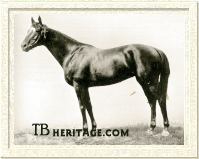
Fair Play
| |
Fair Play was trained by Andrew Jackson Joyner. As a two-year-old, Fair Play scored three times in ten starts, winning the Montauk and Flash Stakes. The champion of the division was unbeaten Colin, who defeated Fair Play on three occasions. At three, Fair Play won seven races from sixteen starts, including the Brooklyn Derby, Coney Island Jockey Club Stakes, Lawrence Realization, Jerome Handicap, Municipal Handicap, and First Special. Fair Play was his sire's leading earner in 1908, the year Hastings was named America's leading sire for the second time.
|
| When racing in New York went dark late in the season due to anti-betting legislation, Fair Play became one of many runners who were shipped to England to race. Fair Play ran six times across the Atlantic, but failed to notch a top three finish. Sent back to the States, it was decided to retire him, as his attitude toward training had definitely soured. Despite the fact that Fair Play had inherited the combustible psyche of Hastings and Cinderella, he proved a popular stallion. His progeny included such important individuals as Chance Shot, Chance Play, Mad Hatter, Mad Play, Stromboli, Display, Chatterton, My Play, Ladkin, and the fillies How Fair and Masda. Daughters of Fair Play produced Sun Beau, High Quest, and Stagehand. But for all this success, the fame of Fair Play as a sire rests on one son--a chestnut colt born in 1917 as a result of his union with the Rock Sand mare Mahubah -- Man o' War. Books have been written about this mighty horse, but suffice it to say he was a winner of 20 of his 21 starts, was idolized as the most famous horse in the world during his lifetime, and was one of the leading sires and sires of broodmares of his era. Through the descendants of his son, War Relic, the line of Spendthrift, Hastings, Fair Play, and Man o' War has survived to the present.
|
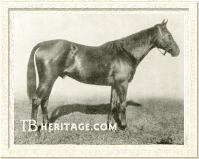
Flittergold
| |
Fairy Gold produced another son of Fair Play named FLITTERGOLD. Foaled in 1911, Flittergold raced through the age of six, and was one of the toughest horses racing at the time. During his long career, Flittergold raced a staggering 150 times, winning 29, with 32 second place finishes and 22 third place finishes. His stakes victories included the Royal Blue, Chesterbrook, and Piccadilly Handicaps. Flittergold also placed in a number of stakes. In 1914, he ran second to Sherwood in the Philadelphia Handicap over 1-1/16 miles at Havre de Grace, and second to Lost Coin in the two mile Laurel Stakes in Maryland. The next season, among his performances was a good second to Harmonicon in the Fall Highweight Handicap, with Flittergold carrying 128 pounds to Harmonicon's 140.
|
Being a full brother to Fair Play and a horse of tremendous constitution, Flittergold got his chance at stud. He stood at Phil Chinn's Himyar Stud on the Russell Cave Road near Lexington. His best offspring was probably Roguish Eye, winner of the Bashford Manor Stakes and second in the Futurity. Some of his other winners included Nancy Langhorne, Breechloader, Goldmark, Crystal Domino, and Fehrah.
An interesting aspect of the stud career of Hastings was the number of stakes winners he sired from mares by Belmont's imported stallion, The Ill-Used, which numbered at least nine. These stakes winners were inbred 4x4 to the half-brothers King Tom and Stockwell, thus 5x5 to the dam of those two stallions, Pocahontas.
It was something of an anticlimax to his splendid stud career that Hastings failed to make much of a mark as a broodmare sire. Perhaps his best producing daughter was NETTIE HASTINGS, a filly from his 1912 crop and produced from the His Highness mare Princess Nettie. She became the dam of four stakes winners, the filly Lucile; the colt Bo McMillan, a winner of the Sanford memorial and Blue Grass Stakes; the filly Rejected; and the Sweep colt Sweep All. This colt's finest racing hour may have come in the 1931 Kentucky Derby, when he finished a fine second to Greentree Stud's Twenty Grand. At stud, Sweep All was not considered the height of fashion, but he was decent, getting some very good representatives like Santa Anita Handicap winner Bay View and the filly Four Winds, a multiple stakes winner on the Chicago circuit. Another offspring of Nettie Hastings was Peter Hastings, a son of Peter Pan. His fame came not on the track, but as the sire of the filly Mata Hari, a tremendously fast individual endowed with a double dose of the volatile Hastings temperament -- Mata Hari was out of a Man o' War mare, which made her inbred 3x4 to Hastings. She was a champion at two and three and became the dam of Spy Song, a high class stakes winner and major sire.
GOLDEN VIEW was a full sister to Fair Play, and was just one year younger. She was unraced. As a broodmare she produced the colt Rock View, a son of Rock Sand. At two, he won the Pimlico Nursery Stakes. At three, he was second to Prince Eugene in the 1913 edition of the Belmont Stakes, but later captured the Withers Stakes, Brooklyn Derby (later re-named the Dwyer Stakes), Travers Stakes, and Lawrence Realization enroute to championship laurels. At four, Rock View took the Toboggan Handicap. His best runner was the filly Pongee, winner of the Ashland Oaks and Essex Handicap.
Golden View had several daughters, and over the decades, she has become ancestress of such important performers as Romanita, Ponte Vecchio, Classy Cathy, and Boundary. One of the favorites for this spring's Triple Crown races, Noble Causeway, is the most recent representative of this family to earn black type.
The aforementioned Tiptoe produced classics-placed Tipsand, a Rock Sand colt which finished third in the 1912 Preakness Stakes. HALF SOVEREIGN produced another classics-placed Rock Sand colt in Half Rock, who finished second to the filly Rhine Maiden in the 1915 Preakness Stakes and second to The Finn in the Belmont Stakes. MARGARET HASTINGS became the dam of the Sweep filly Little Visitor, a winner of the Ashland Oaks and third place finisher to Deeming in the Kentucky Oaks of 1925. OCTOROON became the second dam of Okapi, two time winner of the Toboggan Handicap and second dam of Sweet Verbena, a winner of the Coaching Club American Oaks.
When Hastings died on June 17, 1917, there was a fuzzy chestnut gamboling in the Nursery Stud fields with his dam. The little colt was only a little over six weeks old. Though as yet unnamed, he soon would be -- Man o' War. Hastings was buried in an unmarked grave on the Nursery Stud property, as were The Ill-Used and St. Blaise before him. Eventually, there were graves for Fairy Gold and Beldame -- sadly all unmarked and lost forever, the people who may have known their locations long since passed on. Today, a development of new condominiums rests on the land which once nurtured the famous equine residents of Nursery Stud.
--Liz Martiniak
|
|
|
|

